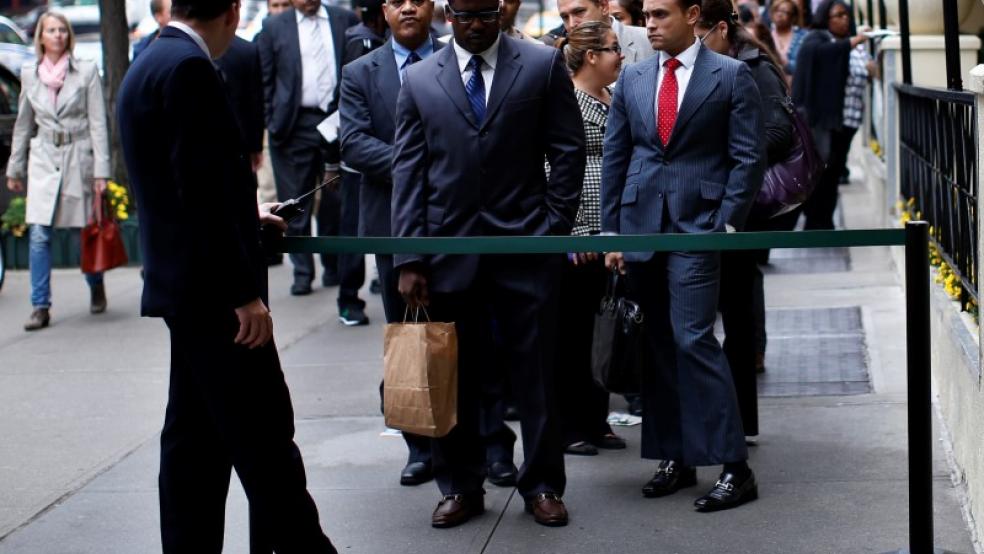Wall Street exhaled heavily Friday on news that job creation in both the public and private sectors accelerated and defied some of the recent speculation that the economy had reached full employment.
Beneath the surface, though, trouble lurked.
Related: Is the Fed Fighting the Trump Rally?
Despite the strong level of job creation — 222,000 in June, 581,000 over the past three months and 47,000 more in the previous two months than originally reported — wage growth remains punk. Even a 4.4 percent unemployment rate hasn't been able to put pressure on salaries, which are growing at just a 2.5 percent rate annually.
Unless conditions change soon, the lack of inflation is going to start to have consequences.
"I would characterize the market as OK but not great," Michael Stull, senior vice president at job placement firm Manpower North America, said as the Street celebrated Friday's much better than expected June nonfarm payrolls report.
"I would feel a little bit better if some of the contradicting numbers of low unemployment rates and low wage growth were more in line with each other," he added.
Related: Is the Fed About to Wage War on the Rich?
That's become a familiar refrain among both investors and economists who wonder why workers aren't making more if the labor market is so seemingly tight. Average hourly earnings rose just 0.2 percent in June, representing a 2.5 percent annualized gain, down from 2.8 percent in February and in line with where the year began.
Construction salaries are up just 2.2 percent and manufacturing barely 2 percent, though leisure and hospitality pay has risen a comparatively robust 4.1 percent, according to Bureau of Labor Statistics data from the past year.
Stull said the same problem continues to vex both workers and employers — a skills mismatch that is keeping qualified workers from taking lower-paying jobs and employers from hiring aggressively in a labor pool they believe is ill-suited for the challenges of more technical positions.
"We need to be rethinking how we develop skills in order to keep the U.S. competitive. We have to integrate education more with work," Stull said. "We need to create the opportunities for people to earn while they learn so they can move into a better job and have better skills."
Related: Bad News for Automakers: The Average US Household Can't Afford a New Car
From a broader economic standpoint, the inflation question gets even stickier.
The year began with hopes that the economy was about to shake free of its 2 percent growth morass, but that narrative has changed. A stream of disappointing economic data has dampened hopes that the Trump administration will be able to achieve its 3 percent growth goal despite continued solid readings in business, consumer and investor sentiment surveys.
Add to that a Federal Reserve with an itchy trigger finger when it comes to interest rates and the picture gets even more complicated.
"Cycles don't last forever, and we're late in this economic cycle, and we have the Fed starting to raise rates. It's a typical combination that causes lower growth and the danger of recession," said Ed Keon, managing director and portfolio manager at QMA. "You throw in the fact that you're going from an unprecedented situation — the lowest rates in human history — and you're trying to get to normal but you don't know what normal is in today's world. It's tricky."
Market still positive
From an investing standpoint, the normally bullish Keon has gotten more cautious about U.S. stocks and has pulled back.
"The market's initial reaction [to the jobs report] seems positive, but I'm not planning on buying any stocks today," he said. "I'd be more likely to sell into a rally if we get one today than to jump into it."
Indeed, stocks have remained positive even amid the conflicting issues over inflation and the Fed's dismissal of low readings as transitory. The optimistic view is that at some point wages will have nowhere to go but up.
"If monthly employment growth remains at the 150,000-200,000 range, the labor market will continue to rapidly tighten, given the slow growth in labor supply," said Gad Levanon, chief economist for North America at The Conference Board. "Wage growth may resume accelerating later in the year."
To be sure, most other parts of the jobs report were solid.
In addition to the headline job growth, the labor force expanded by 361,000 and the ranks of the employed grew by 245,000.
However, the lack of wage growth will remain a vexing problem and could become a bigger headache for policymakers, particularly if President Donald Trump's pro-growth agenda continues to stall.
"We shouldn't take a great deal of comfort in a 'good' jobs number alone," Robert Frick, chief corporate economist at Navy Federal Credit Union, said in a statement. "There are many other factors that come into play which haven't moved, like wages and labor force participation. We're still waiting for wage growth to extend the recovery."
This article originally appeared on CNBC. Read more from CNBC:
Are NATO allies really getting a ‘free ride’? Here’s what the numbers say
Government ethics director who clashed with Trump White House resigns




